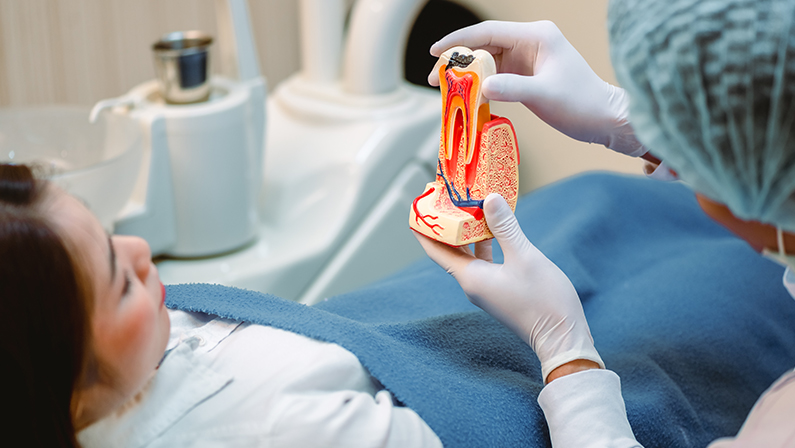Have you ever experienced persistent pain or infection in a tooth that has already undergone a root canal? If so, you might need an apicoectomy procedure. This guide will explain what an apicoectomy is, how it differs from a root canal, who needs it, and more.
What Is An Apicoectomy?
An apicoectomy, also known as root-end surgery, is a dental procedure aimed at removing the tip of the tooth’s root and the surrounding infected tissue. This surgery is often performed when a standard root canal treatment is not sufficient to eliminate the infection or inflammation in the tooth.
Root Canal vs. Apicoectomy

When it comes to treating tooth infections, both root canals and apicoectomies are effective procedures, but they are used in different situations. A root canal is typically the first line of defense against tooth infections. During a root canal, the dentist removes the infected pulp from inside the tooth, cleans and shapes the root canals, and fills them to prevent further infection. This procedure is highly successful in most cases and helps to save the natural tooth while eliminating pain and infection.
However, if a root canal fails or the infection persists, an apicoectomy might be necessary. An apicoectomy is a more specialized surgical procedure that involves removing the tip of the tooth’s root (apex) and any surrounding infected tissue. This is often required when the infection is located in areas that are difficult to reach through a standard root canal. While a root canal is less invasive and generally preferred, an apicoectomy is a valuable alternative for treating stubborn infections and preserving the tooth when other treatments have not been successful. Both procedures aim to save the tooth and prevent further dental complications, but they are chosen based on the severity and location of the infection.
Who Needs an Apicoectomy?
An apicoectomy is typically recommended for patients who have persistent inflammation or infection after a root canal procedure. This surgery is also advised when there are anatomical complexities or blockages that prevent a complete cleaning during a root canal. If you have a tooth with recurring symptoms despite previous treatment, an apicoectomy might be necessary.
How Much Does an Apicoectomy Cost?
The cost of an apicoectomy can vary depending on factors such as the complexity of the case, the location of the tooth, and the expertise of the dentist. On average, the apicoectomy cost ranges from $900 to $1,300. It’s important to consult with your dental provider to get an accurate estimate based on your specific needs.
How an Apicoectomy Procedure Works
If you’ve ever had a root canal that didn’t completely solve your dental issue, you might be wondering how an apicoectomy can help. Let’s delve into the specifics of this procedure and understand how it works to save a problematic tooth.
Here’s a step-by-step breakdown of the Apicoectomy procedure:
1. Diagnosis and Preparation
The first step is a thorough examination by your dentist or endodontist. They will use X-rays to pinpoint the exact location of the persistent infection and assess the structure of the tooth and surrounding bone.
To ensure you don’t feel pain during the procedure, a local anesthetic is administered. This numbs the area around the affected tooth, making the procedure comfortable.
2. Accessing the Root
The dentist makes a small incision in the gum tissue near the infected tooth. This incision is carefully placed to minimize discomfort and promote healing.
The gum tissue is then gently lifted to expose the underlying bone and the tip of the tooth root. This step is crucial for accessing the infected area.
3. Removing the Infection
Using specialized instruments, the dentist removes the infected portion of the tooth root. This includes the very tip (apex) and any surrounding inflamed or infected tissue.
Next, the root canal is thoroughly cleaned from this new access point to ensure no remaining infected tissue or debris is left. This step is vital for preventing future infections.
4. Sealing the Root
A small filling is placed at the end of the root to seal the canal and prevent reinfection. This filling material is biocompatible and designed to integrate with your natural tooth structure.
Once done, the area is carefully inspected to ensure all infected tissue has been removed and the root is properly sealed.
5. Closing the Incision
Lastly, the gum tissue is repositioned and sutured back in place. These stitches are usually small and help the gum heal securely around the tooth.
Your dentist will now provide instructions for post-operative care, including how to manage pain and swelling, and what foods to avoid while the incision heals.
What Happens After the Procedure?
After the procedure, you might experience some swelling and discomfort, which can be managed with prescribed painkillers and ice packs. It’s important to follow your dentist’s aftercare instructions meticulously to ensure proper healing.
Then, a follow-up appointment is typically scheduled to remove any stitches and to check the healing progress. During this visit, your dentist will take additional X-rays to confirm that the infection has been eradicated and the area is healing well.
Finally, for long-term care, maintaining good oral hygiene and attending regular dental check-ups are essential. Your dentist may recommend specific oral care routines to help prevent future infections.
How Long Does It Take to Recover From an Apicoectomy?
Recovery from an apicoectomy usually takes a few days to a week. Most patients can resume normal activities within 24 hours, but it’s advisable to avoid strenuous activities for a few days. Swelling and discomfort are common, but these can be managed with pain relievers and ice packs. Your dentist will provide detailed aftercare instructions to ensure a smooth recovery.
What Are the Risks and Complications of an Apicoectomy?

While an apicoectomy is generally safe and effective, there are some risks and complications to consider. Common issues include pain and swelling, which are usually manageable with pain relievers and cold compresses. Infection at the surgical site is another potential risk, but it can be minimized with proper oral hygiene and the use of prescribed antibiotics. Nerve damage, although rare, is a concern, especially for lower teeth, and can result in temporary or permanent numbness or tingling in nearby areas. For upper teeth, there’s a slight chance of sinus complications due to the proximity of the sinus cavity.
Less common complications include bone healing issues and tooth fractures. The bone around the treated root tip may not heal correctly, leading to prolonged discomfort and possibly requiring additional procedures. The tooth itself can also become more susceptible to fractures during the process. There’s also a chance that the infection might not be entirely eradicated, leading to persistent or recurrent issues that could necessitate further treatment. Being aware of these risks allows patients to make informed decisions and take necessary precautions for a smoother recovery.
What Is the Success Rate of an Apicoectomy?

The success rate of an apicoectomy is relatively high, with studies showing success rates ranging from 75% to 90%. The success of the procedure depends on various factors, including the dentist’s expertise, the tooth’s condition, and the patient’s overall oral health. Proper post-operative care also plays a crucial role in ensuring a successful outcome.
Schedule Your Appointment at Brownstone Dental Today
If you’re experiencing persistent dental issues despite previous treatments, an apicoectomy might be the solution you need. At Brownstone Dental, Dr. Saif Shere, DMD, offers expert apicoectomy surgery in Houston, TX, along with surgical dental services, dental veneers, and cosmetic dentistry. Known as a celebrity cosmetic dentist, Dr. Shere provides top-notch care to ensure your dental health and aesthetic needs are met. Schedule your appointment today by visiting our services page or booking online. Visit us at 9824 Fondren Rd, Houston, TX 77096, and experience expert dental care tailored to your needs.